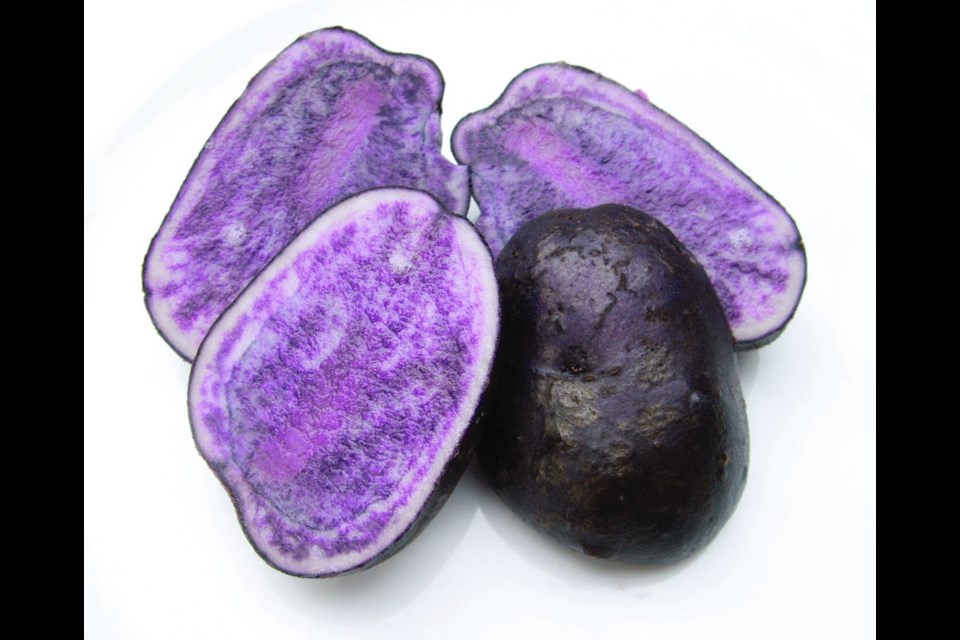Dear Helen: We have enjoyed a large harvest from the Caribe potatoes we grew, but the tubers in the last plants we dug at the end of October were already sprouting. I wasn’t sure what to do with them. Should I have left them in the ground? We don’t have a cool storage room in our home.
A.A.
Caribe is an early-producing potato that can grow large if left in the ground until late in the growing season.
Though some store well, most early potatoes are best dug throughout the summer and early fall, as needed, and used within a few days. Your last Caribe tubers had already begun their next cycle of growth with sprouting. At that stage, the tubers can be dug, the sprouts rubbed off and the potatoes consumed, before they deteriorate further with the process of re-growth.
Late season and some mid-season potatoes are the kind used for storing and winter use. They don’t need any special room, just somewhere dark and cool, preferably at 4 to 6 C. This could be in ventilated boxes placed in a garage or shed, or on carport shelving.
Dear Helen: I have two Christmas cactus plants, which were gifts. They flowered beautifully, but the blooms have now faded. Are these plants that can be kept, or should I compost them?
K.B.
These are undemanding house plants. They are easily kept from year to year, but I’m puzzled by the bloom time of the plants you were given. They should still be flowering. I gather from your note that the flowers had faded by mid-December. Christmas cactus plants begin blooming around the winter holiday season and flower through January. They have scalloped leaf segments.
Two other forest cacti types are Thanksgiving and Easter cacti. Your plants may be Thanksgiving cacti, also called crab claw cacti for their pointed leaf segments. They flower from late fall into winter. Easter cactus plants have rounded leaf segments and flower in spring.
Here are some tips on bringing your plants back into bloom later this year.
The end of flowering signals time for a “rest” period in cool temperatures, ideally in the 10 to 13 C range. Until early spring, water very little, just enough to keep the plants from shrivelling.
Early in the spring resume regular watering and place the plants in bright indirect light. Ideal temperature range during this spring period is 13 to 21 C. If possible, set the plants outdoors for the summer in filtered light.
Begin reducing water again around mid-August. This is to start hardening new growth in preparation for bud set. Leave the plants outdoors until night temperatures fall to 5 C. Than bring them indoors, to a bright window in a cool room that is not used much at night. Dryish conditions, cool temperatures, and naturally shortening days all contribute to a good set of flowerbuds for another round of bloom.
Once flower buds begin to form, begin watering normally, enough to keep the potting mix modestly moist.
Dear Helen: I have a Shinseiki oriental pear that has bloomed, but no fruit formed. Why? Does it need another tree to pollinate it?
M.J.
Oriental pears tend to be self-fruitful, but they benefit from cross-pollination, which helps to promote the formation of more, larger fruit.
I’ve heard and read different opinions on just how self-fruitful Shinseiki (also known as New Century) is. Here is what Tara Austen Weaver writes in her Growing Berries and Fruit Trees in the Pacific Northwest (Sasquatch Books).
“An early ripening, round Asian pear, Shinseiki features crisp flesh and smooth yellow skin — one of the juiciest Asian pears available. It has the satisfying crunch of an apple, with the slightly grainy texture characteristic of Asian pears. Shinseiki is self-fruitful and doesn’t require a pollinator (though it may bear better with one).”
There are several possible reasons for the tree’s failure to form fruit after flowering. There may be a lack of pollinating insects, or perhaps the weather was rainy and windy enough to deter insect activity during bloom. The age of the tree can be another issue. Asian pears can take three years from planting to produce a first crop of fruit, and five years for a full crop.
If you decide to plant a compatible pollinator tree, Chojuro is a recommended variety.



